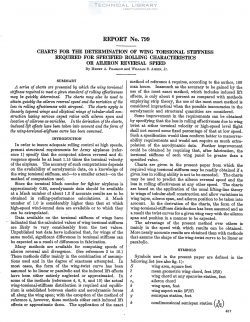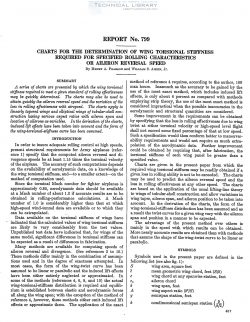naca-report-799

- Version
- 223 Downloads
- 824.28 KB File Size
- 1 File Count
- August 30, 2016 Create Date
- August 30, 2016 Last Updated
National Advisory Committee for Aeronautics, Report - Charts for the Determination of Wing Torsional Stiffness Required for Specified Rolling Characteristics or Aileron Reversal Speed

A series of charts are presented by which the wing torsional
stifness required to meet a given standard of rolling efi'ectiveness
may be quickly determined. The charts may also be used to
obtain quickly the aileron reversal speed and the variation of the
loss in rolling efiectiveness with airspeed. The charts apply to
linearly tapered wings and elliptical wings of tubular—shell 607b-
struction having various aspect ratios with aileron span and
location of ailerons as variables. In the derivation of the charts,
induced lift efi'ects have been taken into account and the form of
the wing-torsional-stifi'ness curve has been assumed.
In order to insure adequate rolling control at high speeds,
present structural requirements for Army airplanes (refer-
ence 1) specify that the computed aileron reversal and di—
vergence speeds be at least 1.15 times the terminal velocity
of the airplane. The accuracy of such computations depends
on the availability of aerodynamic data, on a knowledge of
the wing torsional stiffness, and—to a smaller extent—on the
method of computation used.
Since the terminal Mach number for fighter airplanes is
approm'mately 0.85, aerodynamic data should be available
at a Mach number of about 1.0 if accurate results are to be
obtained in rolling-performance calculations. A Mach
number of 1.0 is considerably higher than that at which
high-speed wind-tunnel data are available or to which they
can be extrapolated. ,
Data available on the torsional stiffness of wings have
’ indicated that the calculated values of wing torsional stiffness
are likely to vary considerably from the test values.
Unpublished test data have indicated that, for wings of the
same model, significant differences in torsional stiffness can
be expected as a result of differences in fabrication.
| File | Action |
|---|---|
| naca-report-799 Charts for the Determination of Wing Torsional Stiffness Required for Specified Rolling Characteristics or Aileron Reversal Speed.pdf | Download |
Comment On This Post